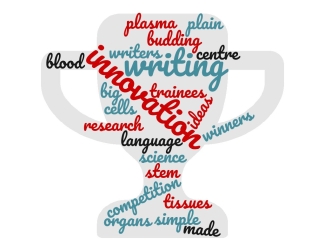Dr. Jennie Haw's prize-winning entry in our Lay Science Writing Competition describes research underway to optimize cord blood donor recruitment for the national, public cord blood bank.
A Canadian Blood Services’ Cord Blood Bank (CBB) collection specialist waits outside a hospital labour and delivery room for a woman to give birth. Sometimes she can hear the newborn cry and when she does she knows that a hospital nurse will soon push through the delivery room doors and hand her a carefully labeled plastic bag containing a still-warm placenta and cord. Once she receives this bag, she quickly pushes the cart to a collection room and begins a finely-timed and orchestrated sequence of steps to extract as much cord blood as possible. Cord blood (the blood remaining in the placenta and cord) contains powerful blood stem cells that can regenerate into any cell in the body’s blood system making these cells an effective treatment for diseases such as leukemia and anemia. The potential to provide stem cell transplants for waiting patients in Canada, and globally, depends on women deciding to donate cord blood.
Since 2015, the CBB has been recruiting, collecting and banking cord blood units from donors in four collection-site hospitals across Canada (Ottawa, Brampton, Edmonton, and Vancouver). Effective donor recruitment is critical to building a robust inventory of cord blood units that meets the needs of patients. As the CBB works to build its inventory, important questions regarding donor recruitment remain.
Why do some women donate cord blood while others don’t? What are donors’ experiences of recruitment and donation? What’s important to women? What does donating cord blood mean to donors and potential donors? How can donor recruitment processes be optimized? Working together with Dr. Dana Devine (Chief Scientist, Canadian Blood Services) and Dr. Jessica Polzer (Associate Professor, Western University), these are some of the questions guiding my research project aimed at optimizing donor recruitment for the CBB.
Very few researchers have examined cord blood donors and recruitment. In one study, researchers found that information and reminders about cord blood donation provided at specific times during a woman’s pregnancy could prompt her to donate. These findings are promising, but the researchers also wrote that any positive effects of these recruitment prompts could be minimized by the broader context in which cord blood donation happens.
As a sociologist, I take the view that nothing in the social world happens in a vacuum. People (and organizations) don’t make decisions or act independently of the broader context within which they live and act. Context includes people, organizational structures, ideas, assumptions, norms, and even the physical environment. Qualitative research methods (data are words and not numbers) are an effective way to learn about people and processes within their specific context. Using these methods, my study generates data through in-depth, one-on-one interviews with people in the “real world” who are best positioned to answer my research questions.
In Phase 1 of my project (2018), I conducted collection site visits and interviewed CBB collection site staff (from all four collection sites) and managers of the CBB. I wanted to understand, in detail, how the CBB operates, and the donor recruitment and cord blood collection processes. Donor recruitment is only one part of a larger CBB system. So, to optimize donor recruitment, it’s necessary to understand how the larger system operates.
Results from these interviews demonstrate that donor recruitment processes are complex and involve multiple people operating within different organizational frameworks (e.g. hospital, CBB), often with different goals and priorities. Our findings confirm the importance of context to donor recruitment and identify influential contextual factors that we categorized into: birthing context (e.g. women’s birthing expectations, women’s physical status), hospital context (e.g. relationships between hospital and cord blood staff, physical layout of the hospital), CBB organizational context (e.g. hours of operation, consent process), and sociocultural context (e.g. language, belief systems). Our results make an important contribution to building an evidence base of contextual factors to consider in cord blood donor recruitment. By publishing these results we’re able to share this evidence with other cord blood banks.
In Phase 2 (2019), I’ll interview donors and potential donors to the CBB to better understand cord blood recruitment and donation from their perspective. Through in-depth interviews with women who have donated and may donate, I’ll generate data about their experiences with cord blood donation, their reasons for donating (or not), what information is important to them when considering cord blood donation, how they came to the decision to donate (or not), and what cord blood donation means to them. Through detailed systematic study of women’s perspectives, we can add to our understanding of the complex recruitment puzzle and provide recommendations to the CBB.
Optimizing donor recruitment processes will contribute to building a robust cord blood inventory, strengthening the stem cell transplant system, and increasing the potential to impact the lives of waiting patients in Canada and around the world.
|
Dr. Jennie Haw is a Canadian Institutes of Health Research (CIHR) Health System Impact Postdoctoral Fellow. Working with Dr. Dana Devine (Chief Scientist, Canadian Blood Services) and Dr. Jessica Polzer (Associate Professor, Western University) the aim of her current project is to optimize cord blood donor recruitment for the national, public cord blood bank. As a sociologist, Jennie is interested in understanding health and health systems in relation to the individual and society. The Canadian Blood Services’ Lay Science Writing Competition provided an excellent opportunity to further develop her communication skills and expand the reach and impact of her research. Jennie spends her free time running on the many paths and trails in Ottawa and the surrounding areas. |
Image

|
The 2018 Canadian Blood Services Lay Science Writing Competition was organized by the Canadian Blood Services’ Centre for Innovation with welcome support from Science Borealis and the Centre for Blood Research at the University of British Columbia.
Related blog posts
The results of our first-ever Lay Science Writing Competition are in, read-on to discover who gets top-prize and what happens next.
Use plain language to tell the story of your research in blood, plasma, stem cells or organs & tissues.
July marks Cord Blood Awareness Month in certain places around the world. In homage to this important campaign we collected a few related stories from the RED archives and share a bit more information about why Cord Blood matters. Cord blood stem cells can be used in the treatment of more than 80...


